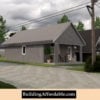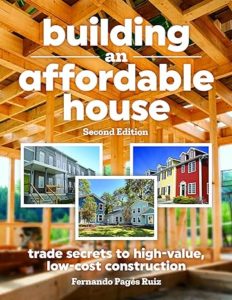When I started building affordable homes, I thought the ideal entry-level model for my area should include at least three bedrooms and cost about $75,000. But when I consulted the newspaper, I found that the least expensive new, three-bedroom house had an asking price of $120,000. My target seemed unreasonable, and perhaps unreachable. But, by using the design and construction techniques outlined in this book, I actually met and exceeded my goal. My first home sold for less than $75,000 and I made a profit. Ten years later, I still build for about $45 a square foot and have no trouble selling houses, even when the real estate market becomes sluggish.
Although I only earn between $8,000 and $12,000 on each house, the system I’ve developed makes it easy to build an average of 30 homes a year without the overhead of an office or staff. I know that bigger payouts are available in the home building industry. Indeed, during my 26 years as a home builder I have put up my share of big, luxury homes. But anyone who’s ridden the roller coaster of a boom-to-bust cycle knows the value of stability.
From a homebuilder’s perspective, competitive, affordable housing represents a basic business plan that blends curb appeal, useful floor space and a low price tag to guarantee quick sales. It’s a blueprint that takes the speculation out of spec building and provides the builder with an elusive commodity in the construction industry: peace of mind.
I have to admit that my first forays into affordable homebuilding came under the auspices of Uncle Sam. I discovered that government subsidies could turn any building project into a success by artificially lowering the sale price. It’s a lucrative game, and some of the most successful builders in the United States devote themselves almost exclusively to government-funded projects. But most builders are turned off to this market niche by the arcane accounting and tax schemes required. It’s a business geared more toward bookkeepers than craftsmen.
The idea of building affordable houses through clever paperwork rather than better building practices seems wrongheaded – after all; even the Taj Majal becomes “affordable” with enough government dough. But I wasn’t moved to put my opinions into action until the bounty of government grants and low-interest loans looked imperiled in the mid-1990s. I had a family to support, and I didn’t want to risk their future on shifting political tides. So, I set out to find ways of building economy without Big Brother. Since then, I have pursued a hard-cost, value-engineering approach to affordability.
Affordability by Design
The goal of affordability-by-design is creating high quality yet inexpensive homes through intelligent planning and construction, not taxpayer dollars. This book describes the art and science of affordable homebuilding through my experience and interviews with hundreds of affordable homebuilders throughout the nation. It explores a meticulous and fussy craft usually plied on entry-level housing, but useful at any price level. Even high-end builders can benefit by learning a few tricks from the masters of thrift, the value-conscious homebuilders and tradesmen whose advice and experience I’ve summarized in this book.
Although we tend to believe that the more we spend, the better we build, the opposite is often true. In the exploration of intelligent, efficient building practices, we can find the means to save money and other natural resources while providing a superior product for our customers.
This book “Building an Affordable Home” reveals the secrets of building better for less. Use it as a resource to explore the possibilities and develop your own cost-cutting approach, that balances marketability, quality and price. That’s a triple play that guarantees immediate success and a secure and sustainable outlook.


